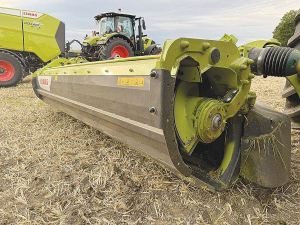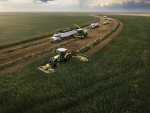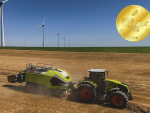The growing popularity of whole-crop cereals for livestock, and in some countries as a food source for anaerobic digesters, has led Claas to develop a new auger-based merging system alongside other grouping options for its latest Disco triple mower ranges.
The newcomers gain dark grey covers in place of the more familiar white canvas skirts to identify the new generation.
The new Disco 9300 Direct Swather does away with the usual conditioner, to replace it with an auger that is used to direct the crop to the middle when merging directly behind the tractor, or alternatively, by opening the rear hood, the crop can be laid on the ground for full width spreading. A second alternative allows one auger to be used at full width spreading, while the other is grouping, so helping to move crop away from the field boundary.
While manufacturers such as Krone and Pöttinger have offered auger-based merging systems for several years, the Claas configuration is different in that it uses a conical shaped auger, with the flights double in height from the outside of the mower to the inside, resulting in the forage moving earlier and tidier end of rows.
While the mowing hardware remains the same as the other Disco 9300 models, a slight ‘tweak’ sees the drive to the augers running through the support arm for the central pivot and out the other side, from where drive belts power the augers. Additional deflector plates at the centre help control the row shape when merging.
Changeover to full width spreading is a push button action in the ISOBUS display or via the Cemis 700 or 1200 terminals, allowing the doors to open hydraulically and the auger directing the crop onto to the ground.
While minimising grain losses from wholecrop is said to be one of the primary reasons for the introduction of the new model, product specialists suggest the configuration might also appeal to users with front and rear set-ups who want to move up to triple mowers but may have limited horsepower. T
The 180hp-plus required for the auger system puts it more in reach, with the added benefit of being able to group crops, but the flipside is losing conditioning.
For those wanting to condition and merge, Claas has also introduced the 9300C Auto Swather version of its conditioner mower/belt merger. This is essentially the same setup as the side-shifting 9700C AS that can be powered by the tractor’s hydraulic and is now available with an oil cooler option.
Another new addition aimed at those wanting a no-frills triple mower is the Disco 8500C Trend. This 8.3m wide mower gains the Hardox steel hood already introduced on the other triple mowers and is also available with a new roller conditioner option (8500RC). Hydraulic functions are operated using the tractor’s spool with pre-selection on the Cemis 10 control box.
The final offering is the introduction of a non-conditioner version of the Disco 1100, said to meet demands of certain markets. In 2017 Claas introduced the Disco 1010 with a slanting rear vertical fold system and a fixed working width. The new 1100 model has hydraulic working width adjustment from 10m to 11m.


















